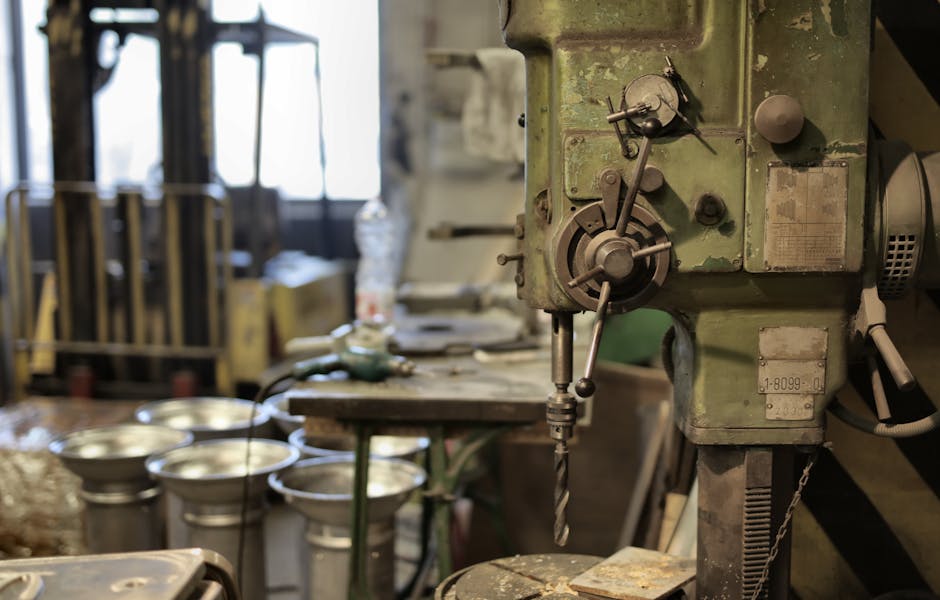London’s Role in the UK’s Manufacturing Landscape: Challenges and Opportunities
London’s position within the UK’s manufacturing landscape is a complex and dynamic one, presenting both challenges and opportunities.
The capital’s significance in driving manufacturing output cannot be understated, yet it also grapples with high operating costs and limited space for industrial facilities.
However, London’s diverse and innovative workforce, coupled with its unparallelled access to global markets, presents a compelling case for the city’s potential to thrive in manufacturing.
Moreover, the prospect of technological advancements further underscores the opportunities that lie ahead.
Understanding London’s role in the UK’s manufacturing landscape necessitates a nuanced exploration of the multifaceted factors at play, and the ensuing implications for the broader industrial sector.
Key Takeaways
- London’s strategic location and well-established infrastructure make it a pivotal hub in the UK’s manufacturing supply chain.
- High operating costs in London impact the competitiveness of the manufacturing sector, requiring companies to explore cost-cutting strategies and leverage advanced technologies.
- Limited space for manufacturing facilities in London poses a challenge for expansion and new entrants, increasing operational expenses and reducing competitiveness.
- London’s access to global markets through its strategic location, well-established infrastructure, and international connexions provides advantages such as penetrating new markets, diversifying customer base, and fostering knowledge exchange.
London’s Impact on Manufacturing Output

While London’s influence on the UK’s manufacturing output is undeniable, it is essential to analyse the specific factors contributing to its impact.
London serves as a pivotal hub in the UK’s manufacturing supply chain, with its strategic location and well-established infrastructure playing a significant role in facilitating the movement of goods and materials. This has a direct impact on the efficiency of the supply chain, contributing to the overall economic growth of the manufacturing sector.
The city’s extensive network of transportation and logistics systems, including ports, airports, and roadways, enables the seamless flow of raw materials and finished products, reducing lead times and costs. Moreover, London’s concentration of skilled labour and access to advanced technologies further enhances the manufacturing processes, driving innovation and productivity. This, in turn, has a positive effect on economic growth, as efficient manufacturing operations contribute to overall national prosperity.
As we delve into the challenges and opportunities associated with London’s manufacturing landscape, it is crucial to understand how high operating costs within the city can impact its role in the UK’s manufacturing sector.
Challenges of High Operating Costs

High operating costs in London pose a significant challenge to the manufacturing sector, impacting its competitiveness both domestically and internationally. As such, companies are compelled to explore various strategies for cost-cutting, including optimising production processes, sourcing materials more efficiently, and leveraging advanced technologies to streamline operations.
These challenges necessitate a focussed approach to mitigating costs while maintaining the quality and competitiveness of products in the market.
Impact on Competitiveness
London’s manufacturing sector faces significant challenges due to the substantial operating costs associated with the city’s economic landscape. High costs affect the competitiveness of London’s manufacturing industry, impacting its supply chain and exacerbating the skills shortage. The table below illustrates the cost-related challenges faced by London’s manufacturers, evoking an emotional response from the audience:
| Challenges | Impact |
|---|---|
| High real estate costs | Limits expansion and investment opportunities |
| Expensive labour | Reduces profit margins and competitiveness |
| Costly energy prices | Increases production expenses and reduces margins |
| Business rates | Adds to operational costs and reduces profitability |
| Transport expenses | Raises logistics costs and affects competitiveness |
These challenges necessitate strategic measures to enhance the sector’s competitiveness and sustainability. Transitioning into the subsequent section, strategies for cost-cutting are vital for London’s manufacturers to mitigate these challenges and thrive in the competitive landscape.
Strategies for Cost-Cutting
Amidst the challenges of high operating costs, London’s manufacturing sector must strategically implement cost-cutting strategies to enhance competitiveness and sustainability.
One key approach is optimising the supply chain to minimise waste and inefficiencies. This involves streamlining processes, reducing inventory levels, and negotiating favourable terms with suppliers.
Automation solutions also play a pivotal role in cost reduction by improving operational efficiency, reducing labour costs, and enhancing production outputs. Embracing technologies such as robotics and AI-driven systems can lead to significant savings in the long run.
Additionally, investing in energy-efficient equipment and sustainable practises can help mitigate escalating operational expenses.
Limited Space for Manufacturing Facilities

The scarcity of available land poses a significant challenge for establishing manufacturing facilities in London. Space constraints and the high cost of land in the city have made it increasingly difficult for manufacturing businesses to find suitable locations for their operations. Additionally, the need for infrastructure development to support manufacturing activities further exacerbates the limited space available for such facilities.
| Challenges | Implications | Potential Solutions |
|---|---|---|
| Limited land availability | Restricts expansion and new entrants into the market | Efficient utilisation of existing space; redevelopment of brownfield sites |
| High cost of land | Increases operational expenses and reduces competitiveness | Government subsidies for land acquisition; incentivising landowners for industrial use |
| Infrastructure strain | Hampers operational efficiency and logistics | Public-private partnerships for infrastructure development; investment in technological advancements |
The combination of these factors makes it imperative for manufacturing businesses in London to devise innovative strategies to overcome space limitations and ensure sustainable growth and competitiveness in the market. Transitioning into the subsequent section about ‘diverse workforce and innovation’, addressing the space constraints will require creative solutions that also embrace diversity and innovation in manufacturing practises.
Diverse Workforce and Innovation

The integration of a diverse workforce and innovative practises within the manufacturing sector presents opportunities for enhanced productivity and competitiveness. Workforce diversity brings together individuals with varied experiences, perspectives, and skills, fostering a dynamic environment that fuels creativity and problem-solving. Embracing workforce diversity not only reflects the values of inclusivity and equity but also leads to a broader range of ideas and approaches, driving innovation within the manufacturing process. Companies that prioritise diversity and inclusion are more likely to develop innovative solutions that address complex challenges and meet the evolving needs of the market.
Innovative solutions, powered by a diverse workforce, can revolutionise manufacturing processes, leading to increased efficiency, cost savings, and the ability to adapt to changing consumer demands. Leveraging technological advancements, such as automation, artificial intelligence, and sustainable practises, can further enhance the industry’s capacity for innovation. Moreover, fostering a culture of continuous learning and improvement can empower employees to contribute groundbreaking ideas and drive the implementation of innovative solutions.
As manufacturing continues to evolve, the integration of a diverse workforce and innovative practises will be pivotal in shaping the sector’s future. This strategic approach not only propels individual companies forward but also contributes to the overall growth and resilience of the UK’s manufacturing landscape. By harnessing the collective power of diverse talents and innovative thinking, London’s manufacturing sector can position itself as a global leader in the industry.
The advancements driven by a diverse workforce and innovative solutions can also provide a competitive edge for accessing global markets, further solidifying London’s role in the UK’s manufacturing landscape.
Access to Global Markets

An imperative aspect for London’s position in the UK’s manufacturing landscape is its access to global markets, facilitating the expansion of its industrial reach and influence. London’s strategic location, well-established infrastructure, and international connexions make it a pivotal hub for global trade and export opportunities. The city’s access to global markets not only enables the import of essential raw materials and components but also provides a platform for UK manufacturers to showcase their products and services to a diverse international audience.
| Advantages of London’s Access to Global Markets |
|---|
| Strategic Location |
| Well-Established Infrastructure |
| International Connexions |
London’s access to global markets presents numerous export opportunities for UK manufacturers, allowing them to penetrate new markets, diversify their customer base, and increase their competitiveness on a global scale. Moreover, it fosters knowledge exchange, encourages innovation, and enables the adoption of best practises from across the world, further enhancing the overall manufacturing landscape in the UK. As global trade continues to evolve, London’s role in facilitating access to global markets will be crucial for driving the growth and sustainability of the UK’s manufacturing sector.
Potential for Technological Advancements

Facilitating the potential for technological advancements in London’s manufacturing landscape is critical for enhancing its global competitiveness and long-term sustainability, consistently alining with evolving industry standards and innovations. Technological innovation plays a pivotal role in driving efficiency, productivity, and quality within the manufacturing sector.
London’s manufacturing industry has the potential to leverage technological advancements to streamline production processes, reduce operational costs, and meet the increasing demand for customisation.
Automation implementation stands as a key area for enhancing London’s manufacturing capabilities. Integrating advanced automation technologies such as robotics, artificial intelligence, and Internet of Things (IoT) can significantly optimise production lines, minimise errors, and enhance overall operational agility. Furthermore, these advancements can lead to the creation of highly-skilled jobs, as the industry requires a workforce with expertise in managing and maintaining these sophisticated systems.
Frequently Asked Questions
What Specific Steps Are Being Taken to Address the Limited Space for Manufacturing Facilities in London?
Addressing space constraints in London’s manufacturing landscape requires innovative solutions such as supply chain optimisation and infrastructure development. This involves utilising advanced technologies, optimising existing space, and strategically planning for future expansion.
How Does London’s Diverse Workforce Contribute to Innovation in the Manufacturing Sector?
Amidst the dynamic tapestry of London’s workforce, diverse perspectives and skills converge to foster innovation in the manufacturing sector. This amalgamation of talents encourages fresh ideas, cross-pollination of knowledge, and the creation of groundbreaking solutions.
What Strategies Are Being Implemented to Improve Access to Global Markets for London-Based Manufacturers?
In response to improving export opportunities, London-based manufacturers are implementing market access strategies such as trade missions, networking events, and leveraging digital platforms to connect with global buyers, fostering growth and competitiveness in international markets.
What Potential Technological Advancements Are Being Explored to Overcome the Challenges of High Operating Costs in London?
Technological advancements such as automation, data analytics, and advanced manufacturing processes are being explored to mitigate high operating costs in London. These innovations optimise space, enhance workforce productivity, and aid in implementing growth strategies for accessing global markets.
How Does London’s Manufacturing Sector Plan to Capitalise on the Opportunities for Growth in the Face of These Challenges?
In navigating challenges, London’s manufacturing sector aims to capitalise on growth opportunities through industry innovation. Leveraging technology and strategic partnerships, the sector seeks to enhance productivity, optimise costs, and expand market reach, fostering sustained progress.
Conclusion
In conclusion, London’s role in the UK’s manufacturing landscape presents both challenges and opportunities.
While high operating costs and limited space for manufacturing facilities are significant obstacles, the city’s diverse workforce, innovation, and access to global markets offer potential for growth.
Despite the challenges, London has the potential for technological advancements that can drive the manufacturing sector forward.
While some may argue that London’s high costs make it difficult for smaller businesses to succeed, the city’s potential for innovation and global impact cannot be overlooked.
Contact us to discuss our services now!
